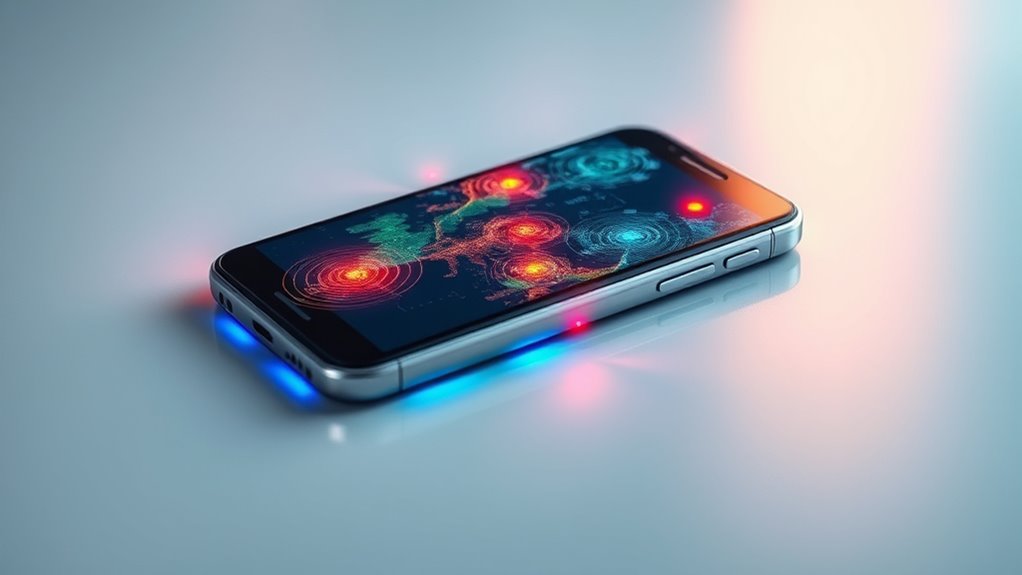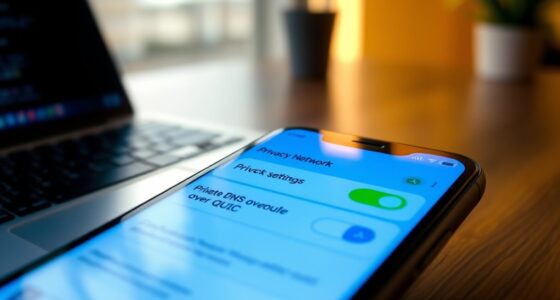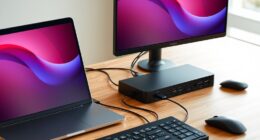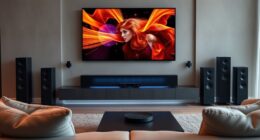UWB positioning in smartphones works by sending short, high-frequency radio pulses that measure the time it takes for signals to travel between devices. This allows for highly accurate, centimeter-level location tracking, ideal for secure access and precise indoor navigation. Compared to Bluetooth or Wi-Fi, UWB offers better accuracy and reliability, even in complex environments. If you want to discover how this technology is shaping future device capabilities, there’s more to explore ahead.
Key Takeaways
- UWB in smartphones uses short, high-frequency radio pulses to measure precise distances to nearby devices.
- It enables centimeter-level indoor positioning by calculating time-of-flight of radio pulses.
- UWB offers higher accuracy and reliability compared to Bluetooth and Wi-Fi, even in complex environments.
- Power consumption is higher during active positioning, requiring efficient management for battery life.
- UWB enhances device security, faster pairing, augmented reality, and precise asset tracking within smart ecosystems.
How UWB Works in Smartphones

Ultra-wideband (UWB) in smartphones works by sending short, high-frequency radio pulses that can accurately measure the distance between devices. When your phone communicates with another UWB-enabled device, it emits these precise pulses. The receiving device detects the signals and measures how long it takes for them to travel back. This time-of-flight measurement allows your phone to calculate the exact distance between the two devices with remarkable accuracy. UWB operates over a wide frequency range, reducing interference and enhancing precision. It’s a quick process that happens in milliseconds, enabling real-time positioning. Unlike other wireless technologies, UWB’s focus on high-frequency, short pulses ensures pinpoint accuracy, making it ideal for applications like device tracking, secure data transfer, and precise spatial awareness. Additionally, the technology’s contrast ratio allows for improved differentiation between objects in complex environments, further boosting its effectiveness in spatial recognition tasks.
Key Differences Between UWB and Other Location Technologies
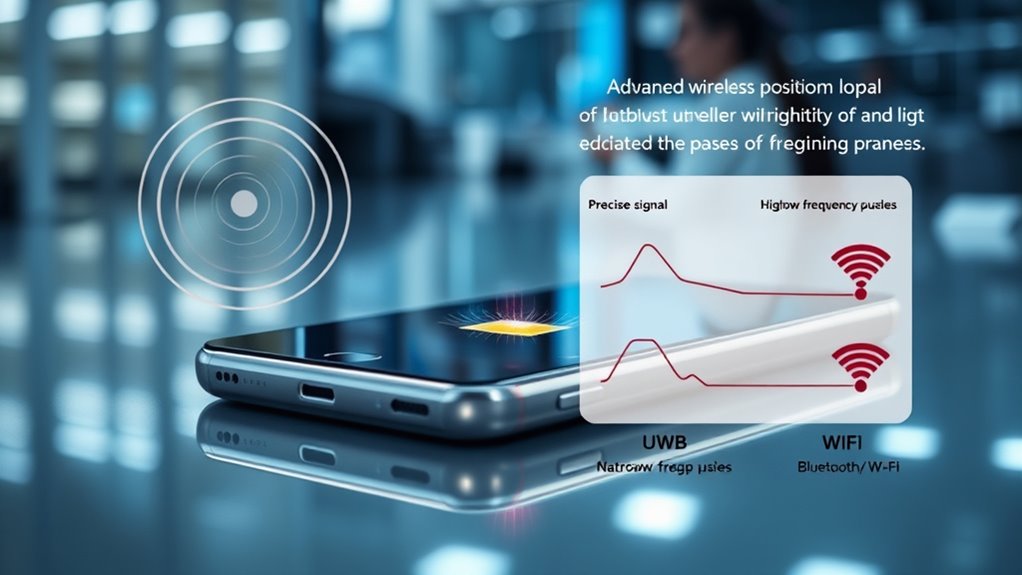
UWB offers higher precision and accuracy compared to most other location technologies, making it it ideal for close-range positioning. It also consumes more power, which can impact battery life if used constantly. Understanding these differences helps you choose the right technology for your specific needs. Additionally, advancements in automation technology continue to influence the development and application of location systems like UWB.
Precision and Accuracy
Have you ever wondered how different location technologies compare in pinpointing your position? UWB stands out with its high precision and accuracy. Unlike GPS, which can be off by several meters indoors or in dense urban areas, UWB can locate you within centimeters. This is because UWB uses short radio pulses that provide detailed distance measurements, reducing errors caused by signal reflection or interference. Other technologies like Bluetooth or Wi-Fi offer decent location data but lack UWB’s pinpoint accuracy. UWB’s ability to deliver precise positioning makes it ideal for applications like secure access or asset tracking. While GPS is great outdoors, UWB excels indoors, providing consistent, reliable, and detailed location data that can markedly improve your smartphone’s ability to understand your environment. Additionally, UWB’s resistance to signal reflection or interference enhances its reliability in complex environments.
Power Consumption Differences
When comparing power consumption, it’s clear that not all location technologies are equal. UWB generally uses more power than Bluetooth or Wi-Fi, but less than GPS. Here are some key points:
- UWB’s high precision requires more energy during active use, especially for rapid data exchanges.
- Bluetooth Low Energy (BLE) consumes less power, ideal for continuous background tracking.
- Wi-Fi positioning balances accuracy and power, using moderate energy.
- GPS is the most power-hungry, draining your battery quickly during constant use.
- Implementing power management techniques can help optimize UWB’s energy efficiency and prolong battery life.
While UWB’s power draw is higher than some tech, it’s optimized for short bursts, minimizing overall impact. You get better accuracy without sacrificing too much battery life, especially with intelligent power management.
Benefits of UWB for Users and Manufacturers
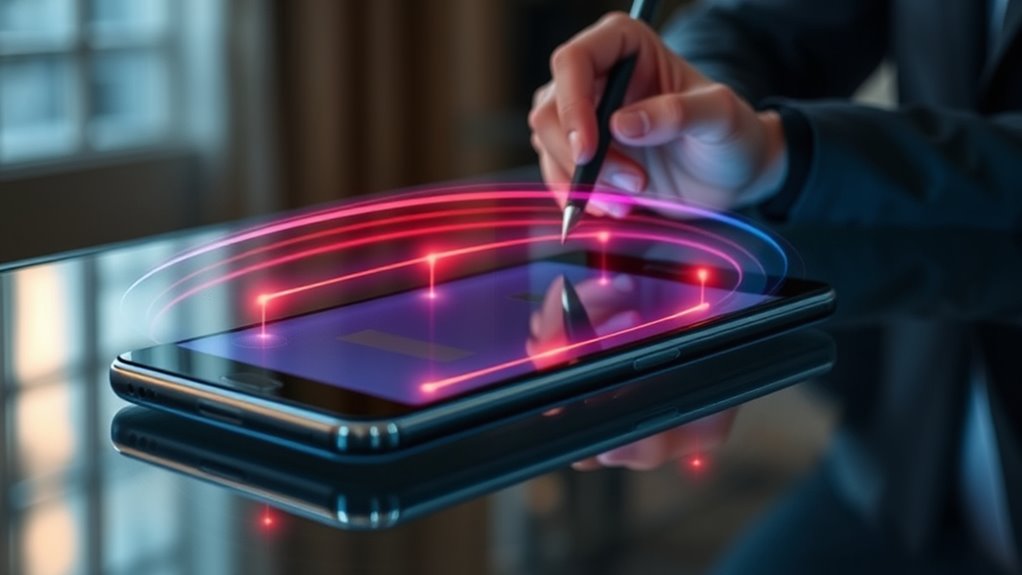
Ever wondered how Ultra-Wideband technology enhances your smartphone experience and benefits manufacturers? UWB provides precise location data, making features like secure device unlocking and accurate tracking possible. For you, this means smoother interactions, faster pairing, and improved device security. Manufacturers benefit by creating smarter, more efficient products with enhanced spatial awareness, enabling better integration with accessories and smart home devices. UWB also supports innovations like spatial awareness for augmented reality, which can elevate your user experience. Additionally, UWB’s ability to improve device interoperability reduces manufacturing costs and enables new functionalities. This technology also facilitates energetic alignment by allowing devices to communicate more seamlessly, enhancing overall user satisfaction. Overall, UWB makes your smartphone more intuitive, secure, and versatile, while helping manufacturers develop better, more competitive products that meet your evolving tech expectations.
Common Applications of UWB in Mobile Devices
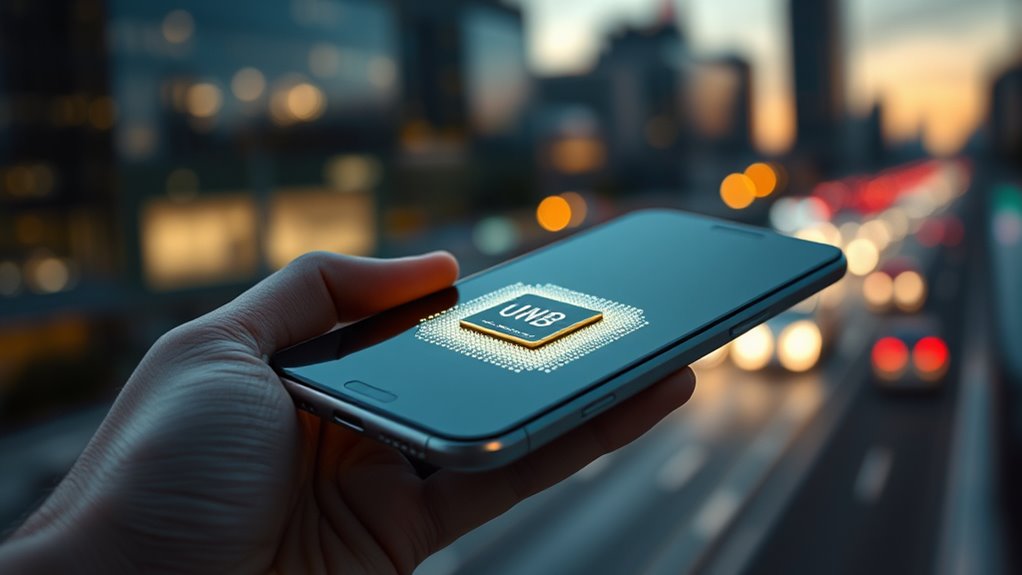
UWB technology enables your devices to track each other with incredible accuracy, making device management seamless. It also enhances augmented reality experiences by providing precise spatial data. These applications show how UWB is transforming the way you interact with your smartphones. Additionally, the integration of spatial awareness features improves navigation and indoor positioning capabilities.
Precise Device Tracking
Precise device tracking is one of the most impactful applications of UWB technology in smartphones, enabling accurate spatial awareness and interaction. With UWB, you can locate your device or accessories with remarkable accuracy, even in cluttered environments. This technology allows you to do things like:
- Find your lost phone or earbuds quickly within a room.
- Unlock doors or access secure areas automatically when nearby.
- Share files seamlessly by establishing direct, close-range connections.
- Control smart home devices precisely, like adjusting lights in a specific room.
- The technology also supports the use of anti-spoofing measures to ensure secure and reliable device interactions.
This level of accuracy enhances your everyday experience, making device management more intuitive and efficient. UWB’s ability to precisely track devices paves the way for smarter, more responsive interactions with your gadgets and environment.
Enhanced Augmented Reality
Enhanced augmented reality experiences become more immersive and accurate when smartphones leverage the precise spatial data provided by UWB technology. With UWB, your device can accurately determine its position relative to real-world objects, enabling AR applications to overlay digital content seamlessly onto physical surroundings. This precision improves interactions in gaming, navigation, and interior design, making virtual elements respond naturally to your movements and environment. For example, in retail, UWB helps you virtually place furniture in your room to see how it fits. In navigation, it provides more reliable indoor positioning, guiding you precisely through complex spaces. Overall, UWB enhances AR by delivering real-time, centimeter-level accuracy, creating richer, more interactive experiences that feel genuinely integrated with the physical world around you. This technology also enhances the overall accuracy of spatial data, further elevating AR capabilities.
Challenges and Limitations of UWB Technology
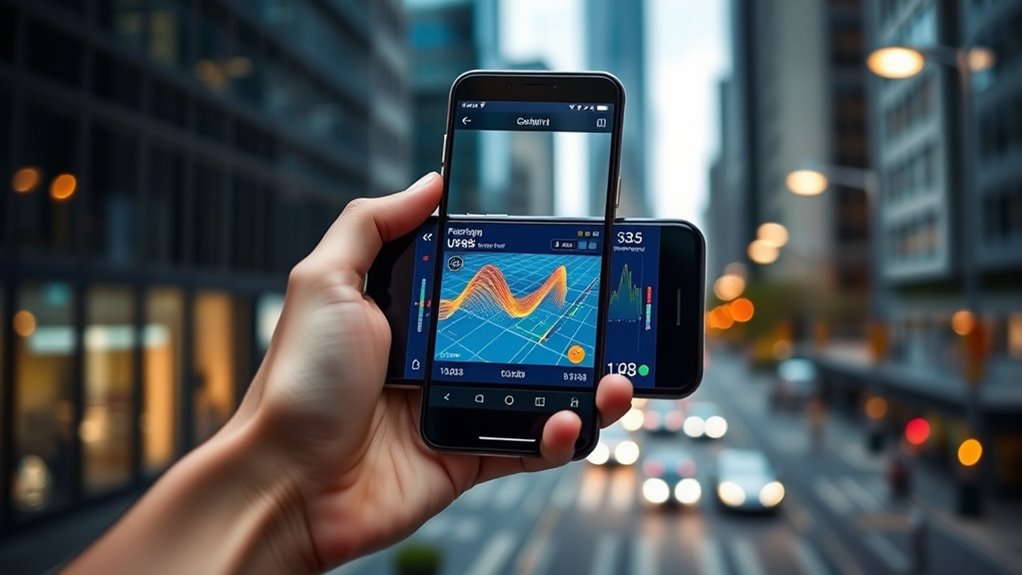
Despite its promising accuracy, UWB technology faces several challenges that can hinder its widespread adoption in smartphones. First, environmental factors like walls and furniture can disrupt signals, reducing reliability. Second, UWB consumes significant power, which can drain your phone’s battery faster. Third, the technology requires precise calibration, making setup more complex for everyday users. Fourth, high manufacturing costs limit affordability, preventing mass-market penetration. Additionally, UWB’s effective range is limited, making it less suitable for large-scale applications. These issues mean that while UWB offers impressive precision, balancing performance with practicality remains a challenge. Overcoming these limitations will be key to *accessing* its full potential in future smartphone features and widespread use. Moreover, integrating UWB into daily devices involves developing creative solutions to address these technical hurdles effectively.
Future Trends and Developments in UWB Positioning

Looking ahead, advancements in UWB technology are poised to address current challenges and open new possibilities for smartphones. Expect increased accuracy and reliability in indoor and complex environments, making precise navigation more accessible. Innovations like integrated AI will enable smarter location-based services, such as dynamic object tracking and enhanced augmented reality experiences. Future UWB chips will become more energy-efficient, extending battery life without sacrificing performance. Additionally, interoperability between devices will improve, fostering seamless multi-device ecosystems. As standards evolve, UWB’s role in secure access, contactless payments, and IoT integration will expand. These developments will make UWB a cornerstone of next-generation smartphones, offering more intuitive, secure, and versatile positioning capabilities that enhance everyday interactions and connectivity. Furthermore, ongoing research aims to improve technology integration, paving the way for more comprehensive and intelligent use cases.
Frequently Asked Questions
How Accurate Is UWB Compared to GPS in Indoor Environments?
You’re wondering how UWB compares to GPS indoors. UWB offers much higher accuracy, often within a few centimeters, making it ideal for indoor positioning. GPS struggles indoors because signals weaken or get blocked. So, while GPS might be accurate to meters outside, UWB provides precise location data indoors, helping you navigate complex spaces easily. This makes UWB a superior choice for indoor tracking and spatial awareness.
What Are the Privacy Concerns Related to UWB Tracking?
You might worry about privacy when it comes to UWB tracking, as it can precisely locate devices indoors. This technology could be exploited for unauthorized tracking or data collection, risking your personal information. If not properly secured, malicious actors might access location data, leading to privacy breaches. To protect yourself, verify your device’s security settings are updated and only share location info with trusted apps and services.
Can UWB Be Integrated With Other Smartphone Sensors?
You can definitely integrate UWB with other smartphone sensors like GPS, accelerometers, and gyroscopes to enhance location accuracy and functionalities. By combining these sensors, you get more precise positioning and better contextual awareness, which can improve navigation, AR experiences, and device interactions. Developers often leverage this integration to create seamless apps that adapt to your environment, making your smartphone smarter and more responsive to your needs.
How Does UWB Impact Battery Life in Smartphones?
Imagine your smartphone as a marathon runner—UWB is like an energy boost. While UWB improves location accuracy, it does consume extra battery power, especially during continuous use. You might notice faster battery drain when actively using UWB features, similar to how a runner tires out quicker when pushing harder. However, with optimized power management, the impact stays minimal, letting you enjoy advanced features without sacrificing your phone’s longevity.
Are There Any Health Risks Associated With UWB Signals?
You might wonder if UWB signals pose health risks. Current research shows that UWB operates at very low power levels, similar to other wireless technologies like Wi-Fi and Bluetooth. Regulatory agencies, such as the FCC and ICNIRP, have set safety limits, and UWB stays well within these. So, based on existing evidence, you shouldn’t worry about significant health risks from using UWB in smartphones.
Conclusion
So, now you know UWB isn’t just fancy tech for geeks. It’s here to revolutionize your smartphone’s precision game—no more guessing games or misplaced keys. Sure, there are hiccups, but hey, who doesn’t love a good tech challenge? Get ready to ditch outdated GPS and embrace the future where your phone practically knows where you are—and what you’re doing—better than you do. Welcome to the age of ultra-wideband brilliance!
